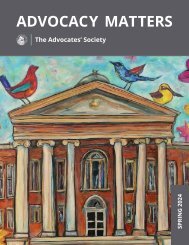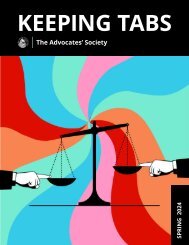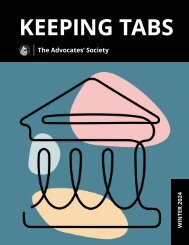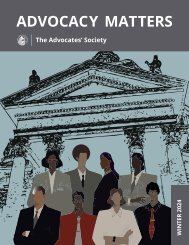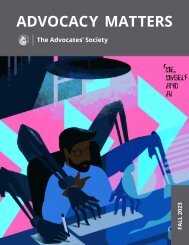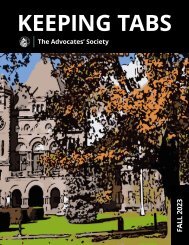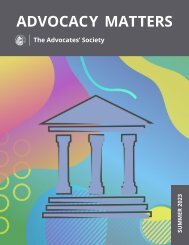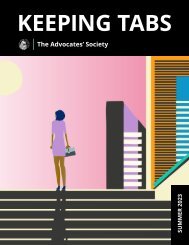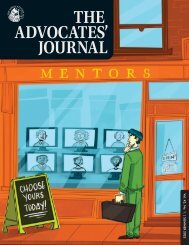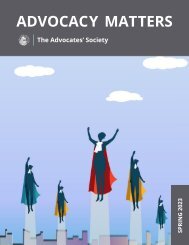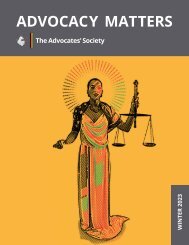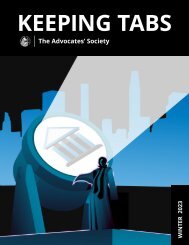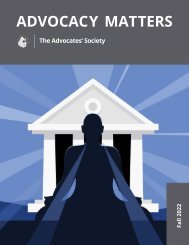Keeping Tabs - Spring 2020
Stay up-to-date on news and events from our Young Advocates' Standing Committee (YASC) with Keeping Tabs.
Stay up-to-date on news and events from our Young Advocates' Standing Committee (YASC) with Keeping Tabs.
Create successful ePaper yourself
Turn your PDF publications into a flip-book with our unique Google optimized e-Paper software.
The election of the Stop SOP “slate” as<br />
benchers of the Law Society of Ontario in<br />
2019 was a low point for supporters of EDI,<br />
however this has also coincided with unprecedented<br />
public discourse about systemic<br />
racism in the legal profession. In your view<br />
as a scholar of CRT, has the public discourse<br />
about race been a silver lining in otherwise<br />
difficult times for EDI? Is racial literacy improving<br />
among lawyers?<br />
While the election of the Stop SOP slate was disappointing,<br />
and while their rhetoric is, in particular,<br />
disheartening for the next generation<br />
of racialized lawyers, I think three silver linings<br />
have emerged from the election and the ensuing<br />
debate surrounding the Statement of Principles:<br />
(1) the inconsistency and (unintended)<br />
transparency of the shifting Stop SOP position<br />
unmasked the regressive politics of various<br />
lawyers in the profession; (2) the SOP debates<br />
brought many lawyers who do not typically reflect<br />
on issues of race and racism into the conversation;<br />
and (3) the support for equality initiatives<br />
within the law society has galvanized a<br />
broad coalition of progressive lawyers and built<br />
solidarity along lines of race, gender, class, indigeneity,<br />
sexuality, disability, and more (though<br />
I acknowledge that the SOP discourse has concentrated<br />
on issues of gender and race, such<br />
that other vectors of oppression warrant greater<br />
reflection and discussion).<br />
Many law firms now have diversity committees,<br />
EDI policies and/or provide training on<br />
topics such as unconscious bias. Are these<br />
approaches adequate?<br />
Adequate to what end? Law firms—and the<br />
law more generally—have a complex relationship<br />
with racial justice. And the sufficiency<br />
of particular internal measures depends<br />
on the objectives of those measures. If law<br />
firms want to decrease unconscious bias—<br />
one of myriad forms through which racism is<br />
spread—then unconscious bias training may<br />
be effective. But if law firms want to develop a<br />
truly inclusive culture they will need to reckon<br />
with the various ways in which existing legal<br />
cultures systemically disadvantage marginalized<br />
communities. And if law firms want to<br />
grapple with how they participate in a competitive<br />
and capitalistic enterprise—which itself<br />
perpetuates racial subordination—they<br />
will have to fundamentally rethink the work<br />
they do, how they are compensated for it, and<br />
the prevailing legal order that governs them.<br />
We are interested in the language used to describe<br />
and address racism. Many initiatives<br />
in the profession use language such as “diversity<br />
and inclusion” or “unconscious bias”<br />
while avoiding more direct language such as<br />
“anti-black racism,” “white privilege” or “cultural<br />
whiteness.” Is this a shortcoming of EDI<br />
approaches or a necessary stepping stone?<br />
Can you comment on choice of language and<br />
how it relates to the broader process of racial<br />
justice education?<br />
Language matters. The words we use to describe<br />
our world and experiences limit how we<br />
imagine and interpret them. Further, the more<br />
we use codes and euphemisms, the less we<br />
speak directly and candidly about the forms<br />
of racial subordination that we are seeking to<br />
address. This does not mean that phrases like<br />
“diversity and inclusion” or “unconscious bias”<br />
are unhelpful. Indeed, in certain contexts,<br />
such umbrella terms do productive conceptual<br />
work. But I think it is also critical, when discussing<br />
these concepts in greater detail, to engage<br />
with the more granular aspects of racial hierarchy<br />
they capture.<br />
What are three things every lawyer can do<br />
to incorporate CRT principles into their daily<br />
practices?<br />
(1) Acknowledge the ways in which privilege<br />
grants them unearned advantages; (2) Reflect<br />
on how systemic racism within their practice<br />
disadvantages racialized communities; and (3)<br />
Commit to outcomes, not just process. For example,<br />
if after ten years of diversity initiatives your<br />
firm is not substantially more diverse—at all levels<br />
of seniority—then ask why, and do more.<br />
Do you have any general advice for young<br />
advocates and firms who want to meaningfully<br />
promote EDI in the profession?<br />
Be comprehensive. Racism comes in many<br />
forms, including: systemic racism (i.e., norms<br />
that disparately impact racialized communities);<br />
implicit bias (i.e., unconscious negative<br />
associations with racialized people); and<br />
microaggressions (i.e., common interactions<br />
that, with accumulation, create a sense of<br />
exclusion in racialized people). Any meaningful<br />
EDI program must account for the various<br />
ways in which race is a site for exclusion<br />
within the profession.<br />
You recently drafted the moot problem for<br />
the Julius Alexander Isaac Moot, administered<br />
by the Black Law Students’ Association<br />
of Canada. The problem involved an issue of<br />
racial profiling and mooters were required<br />
to advance not only legal arguments, but<br />
also theoretical arguments rooted in CRT<br />
in support of their arguments. Why was<br />
it important to incorporate CRT into a law<br />
school moot? In what ways would improved<br />
knowledge and understanding of CRT enhance<br />
lawyers’ abilities and client service ?<br />
On question one—the importance of explicitly<br />
incorporating CRT into the moot—I believe<br />
there is an imperative for more CRT in Canadian<br />
legal academia. Last year, I tweeted about<br />
where CRT is located in Canadian universities.<br />
Many scholars in other disciplines—e.g., sociology,<br />
anthropology, education—said that<br />
CRT featured prominently in their education<br />
or pedagogy. In contrast, relatively few legal<br />
scholars and law students taught or learned<br />
CRT. I view the Isaac Moot as a small means<br />
through which I can expose more students to<br />
critical legal thought, and specifically, critical<br />
legal thought about race.<br />
On question two—how CRT enhances lawyer<br />
competence—I think that, while CRT enhances<br />
lawyer competence, it more importantly<br />
enhances social responsibility. Critical reflection<br />
on law and power absolutely enhances<br />
legal skill. Indeed, effective legal advocacy<br />
necessarily grapples with how power and<br />
context influence human experience and legal<br />
reasoning. For example, a defence lawyer<br />
not conversant in racism and colonialism is,<br />
quite frankly, missing a critical lens through<br />
which to interpret the experience of their clients<br />
and advocate against the systems that<br />
oppress those clients. But, more importantly,<br />
CRT pushes lawyers to think deeper about<br />
how the existing legal order itself is a site of<br />
racial subordination. In this way, greater instruction<br />
in CRT will not only promote more<br />
competent lawyers, but a more progressive legal<br />
system. And, in anticipation of this point<br />
being unfairly criticized by some as reflecting<br />
my desire for ideological brainwashing in<br />
the legal academy, let me say this: neutrality<br />
is ideological—a political commitment to the<br />
status quo. If you teach systemic racism in<br />
criminal law, you are teaching criminal law.<br />
If you teach colour blindness in criminal law,<br />
you are teaching white supremacy.<br />
22 23




